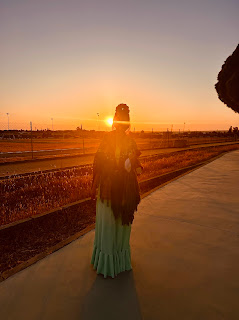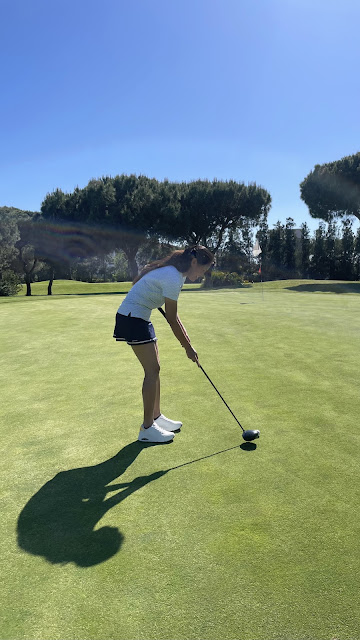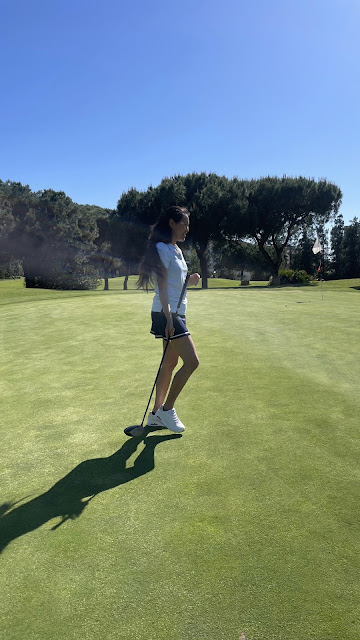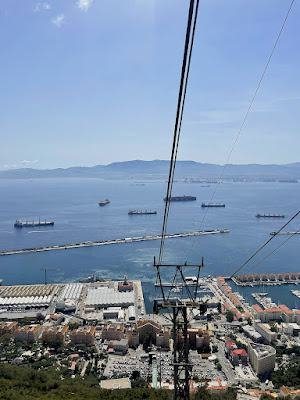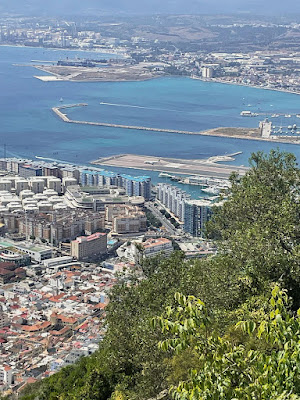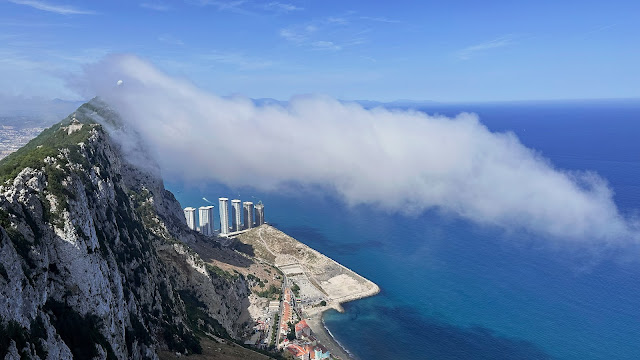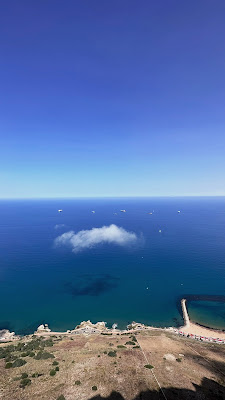ครั้งแรกของแอนกับเทศกาล Romería ที่สเปน – ม้า ฟลาเมงโก และน้ำใจของเพื่อนที่ทำให้รู้สึกว่าที่นี่ก็เป็นบ้าน
บางทีเรื่องดี ๆ ในชีวิตก็เริ่มต้นจากคำชวนสั้น ๆ อย่าง “อยากไป Romería กับเรามั้ย?”
และนั่นแหละค่ะ…คือจุดเริ่มต้นของวันที่แอนยังยิ้มอยู่ทุกครั้งที่นึกถึง
เพื่อนชาวสเปนของแอนสองคนคือ Teo กับ Maria ชวนแอนไปร่วมเทศกาลที่ชื่อว่า La Romería de San Isidro ที่เมือง Cartaya ซึ่งตอนแรกแอนไม่ได้รู้เลยด้วยซ้ำว่ามันคืออะไร แต่ก็คิดแค่ว่า เอ้า…ไปลองดู! และมันกลายเป็นวันหนึ่งที่แอนจะไม่มีวันลืมเลยจริง ๆ
🐎 บรรยากาศเหมือนหนังคาวบอย
สิ่งแรกที่ตกใจเลยคือ…ม้าเต็มไปหมดค่ะ! ตั้งแต่เด็กเล็ก ๆ ไปจนถึงผู้ใหญ่ ทุกคนขี่ม้ามากันอย่างเท่! แล้วไม่ได้ขี่เฉย ๆ นะ แต่ทุกคนแต่งตัวกันสวยหล่อแบบจัดเต็ม ผู้หญิงใส่ชุดฟลาเมงโกสวย ๆ มีระบายฟูฟ่อง ส่วนผู้ชายก็ใส่เสื้อแจ็กเก็ต หมวกปีกกว้าง รองเท้าเป็นบู๊ต คือมันทั้งสวยทั้งเท่แบบคลาสสิกมาก
ตอนนั้นแอนไม่ได้แต่งอะไรไปเลยค่ะ ยอมรับเลยว่าแอบรู้สึก “น่าจะเตรียมตัวมากกว่านี้” ฮ่าๆๆ
เลยแอบตั้งเป้าไว้เลยว่า ถ้าปีหน้าได้มาอีก แอนจะจัดเต็มทั้งชุด แล้วก็อาจจะหัดเต้นฟลาเมงโกไว้ด้วย!
💃 แล้ว Romería คืออะไร?
หลังจากแอบ Serch Google และฟัง Teo and Maria ก็ได้รู้ว่า La Romería คือเทศกาลแสวงบุญที่มีรากมาจากศาสนาคริสต์ค่ะ โดยในเมือง Cartaya นี้เขาจะจัดขึ้นเพื่อเฉลิมฉลองนักบุญที่ชื่อว่า San Isidro Labrador ซึ่งเป็นนักบุญอุปถัมภ์ของเกษตรกร
Saint Isidro เป็นชาวนาธรรมดา ๆ ที่มีความศรัทธาแรงกล้า และเชื่อกันว่าเป็นผู้ปกป้องชาวไร่ชาวนาให้มีพืชผลดี น้ำเพียงพอ และชีวิตเรียบง่ายที่มีคุณค่า
ในงาน Romería de San Isidro ที่เมือง Cartaya จะมีการจัดประมูลแบบดั้งเดิมที่เรียกว่า “Subasta de la Vara del Santo” ซึ่งผู้ที่ประมูลได้ในราคาสูงสุด จะได้รับเกียรติให้เป็น “Hermano Mayor” หรือผู้ถือไม้เท้าศักดิ์สิทธิ์ของนักบุญ San Isidro ในปีถัดไป
ผู้ที่ได้รับตำแหน่งนี้จะมีบทบาทสำคัญในขบวนแห่และพิธีกรรมทางศาสนาต่าง ๆ ตลอดเทศกาล ถือเป็นเกียรติสูงในชุมชน
ตัวอย่างเช่น:
-
ปี 2022: Rocío Pereira García ชนะการประมูลในราคา 9,100 ยูโร (ประมาณ 360,000 บาท)
-
ปี 2019: ครอบครัว Álvarez-Custodio ประมูลได้ในราคา 9,200 ยูโร (ประมาณ 365,000 บาท)
แต่ความเจ๋งของ Romería ไม่ใช่แค่เรื่องศาสนาเท่านั้น มันคือการรวมตัวของผู้คนในหมู่บ้าน การเดินทางไปด้วยกันทั้งครอบครัว การกินข้าวใต้ต้นไม้ การหัวเราะ การร้องเพลง และการใช้เวลาช้า ๆ ร่วมกันในแบบที่เราอาจลืมไปแล้วว่าโลกเคยมีแบบนี้
🍷 ในเต็นท์ของครอบครัว Teo – บรรยากาศง่าย ๆ ที่รู้สึกเป็นส่วนหนึ่ง
ตอนที่แอนเข้าไปในเต็นท์ของครอบครัว Teo แรก ๆ ก็ยังเกร็งนิดหน่อยค่ะ เพราะทุกคนคุยกันเป็นภาษาสเปนหมดเลย แล้วแอนก็ฟังได้บ้างไม่ได้บ้าง
แต่สิ่งที่ทำให้รู้สึกดีคือ...ทุกคนคุยกันสนุกมาก หัวเราะกันตลอด แซวกันเหมือนญาติพี่น้อง บางคนก็มาทักแอน แม้จะพูดไม่ค่อยรู้เรื่องกันแต่ก็พยายามคุย ยื่นขนมมาให้ ยิ้มให้ คือมันไม่ได้ต้องทำอะไรพิเศษเลย แต่มันรู้สึกได้ว่า…เขาอยากให้เราอยู่ตรงนั้นด้วยกัน
โชคดีที่ Teo พูดภาษาอังกฤษได้ดีมาก แล้วเขาก็พยายามช่วยแปลให้แอนเข้าใจในบางช่วงที่ทุกคนพูดกันเร็ว ๆ หรือพูดคำเฉพาะที่แอนไม่เคยได้ยินมาก่อน ซึ่งมันช่วยมากจริง ๆ ค่ะ แอนเลยไม่รู้สึกหลุดจากวงสนทนาเท่าไหร่
แอนก็นั่งไป ฟังเขาคุยกันบ้าง หัวเราะตามบ้าง มันง่ายมากที่จะรู้สึกว่าเรา "อยู่ได้" ตรงนี้
มันทำให้แอนนึกถึงเวลาที่อยู่เมืองไทยเลยค่ะ — คนไทยก็เป็นแบบนี้แหละ อบอุ่น ง่าย ๆ เข้าถึงง่าย ไม่ต้องรู้จักกันมากก็แชร์ขนม แชร์รอยยิ้มให้กันได้
ที่ตรงนั้นไม่ใช่บ้าน แต่ มันมีความรู้สึกคล้ายบ้านเลยค่ะ
ตอนที่แอนเข้าไปในเต็นท์ของครอบครัว Teo แรก ๆ ก็ยังเกร็งนิดหน่อยค่ะ เพราะทุกคนคุยกันเป็นภาษาสเปนหมดเลย แล้วแอนก็ฟังได้บ้างไม่ได้บ้าง
แต่สิ่งที่ทำให้รู้สึกดีคือ...ทุกคนคุยกันสนุกมาก หัวเราะกันตลอด แซวกันเหมือนญาติพี่น้อง บางคนก็มาทักแอน แม้จะพูดไม่ค่อยรู้เรื่องกันแต่ก็พยายามคุย ยื่นขนมมาให้ ยิ้มให้ คือมันไม่ได้ต้องทำอะไรพิเศษเลย แต่มันรู้สึกได้ว่า…เขาอยากให้เราอยู่ตรงนั้นด้วยกัน
โชคดีที่ Teo พูดภาษาอังกฤษได้ดีมาก แล้วเขาก็พยายามช่วยแปลให้แอนเข้าใจในบางช่วงที่ทุกคนพูดกันเร็ว ๆ หรือพูดคำเฉพาะที่แอนไม่เคยได้ยินมาก่อน ซึ่งมันช่วยมากจริง ๆ ค่ะ แอนเลยไม่รู้สึกหลุดจากวงสนทนาเท่าไหร่
แอนก็นั่งไป ฟังเขาคุยกันบ้าง หัวเราะตามบ้าง มันง่ายมากที่จะรู้สึกว่าเรา "อยู่ได้" ตรงนี้
มันทำให้แอนนึกถึงเวลาที่อยู่เมืองไทยเลยค่ะ — คนไทยก็เป็นแบบนี้แหละ อบอุ่น ง่าย ๆ เข้าถึงง่าย ไม่ต้องรู้จักกันมากก็แชร์ขนม แชร์รอยยิ้มให้กันได้
ที่ตรงนั้นไม่ใช่บ้าน แต่ มันมีความรู้สึกคล้ายบ้านเลยค่ะ
💛 ขอบคุณจากใจ…สำหรับมิตรภาพที่สวยงาม
ก่อนจะจบบล็อกนี้ แอนอยากเขียนไว้ตรงนี้เลยว่า...
“ขอบคุณนะ Teo และ Maria ขอบคุณที่เป็นเพื่อนที่ดี เป็นคนที่แอนโชคดีมาก ๆ ที่ได้รู้จัก และที่ทำให้สเปนรู้สึกเหมือนเป็นบ้านอีกหลังของแอนจริง ๆ”
บางครั้งการย้ายประเทศมันก็เหงาอย่างบอกไม่ถูก แต่มิตรภาพดี ๆ แบบนี้แหละ ที่ทำให้ทุกอย่างมันอบอุ่นขึ้นมาได้แบบไม่ต้องพยายามอะไรเลย
🚗 ปล. ถ้าใครอยากมาเที่ยวแถวนี้...นอกจากมากอล์ฟ
ช่วงนี้แอนอยู่ที่สเปนค่ะ แถว ๆ แคว้นอันดาลูเซีย (Andalucía)
หลายคนอาจรู้จักที่นี่จากสนามกอล์ฟสวย ๆ และอากาศดี ๆ ตลอดทั้งปี
แต่จริง ๆ แล้วที่นี่มีอะไรน่าสนใจมากกว่านั้นอีกเยอะเลย — หมู่บ้านเล็ก ๆ ที่น่ารัก เมืองประวัติศาสตร์แบบอาหรับ-สเปน ผืนป่าธรรมชาติที่เงียบสงบ และงานเทศกาลแบบ Romería
ใครที่อยากมามากกว่าตีกอล์ฟ หรืออยากได้ประสบการณ์ท้องถิ่นจริง ๆ แบบที่นักท่องเที่ยวทั่วไปอาจไม่เห็นแอนกับทีมก็มีจัดทัวร์เที่ยวแคว้น Andalucía ด้วยนะคะ :)
ไว้วันหลังแอนจะมาเล่าเพิ่มเติมในบล็อกอื่น ๆ ว่าแต่ละเมืองมีอะไรน่าประทับใจบ้าง
แต่ถ้าใครสนใจอยากมาสัมผัสตั้งแต่ตอนนี้ ก็ทักมาได้เลยน้า 💛
🌾 My First Time at the Romería Festival in Spain – Horses, Flamenco, and the Kindness That Made It Feel Like Home
Sometimes, the best things in life begin with a simple question like:
“Do you want to come to the Romería with us?”
And just like that… it became one of those days I still smile about every time I think of it.
Two of my Spanish friends, Teo and Maria, invited me to a local festival called La Romería de San Isidro in the town of Cartaya. At first, I had no idea what it was about, but I thought — why not? Let’s go see what it’s like!
And honestly, it turned out to be a day I’ll never forget.
🐎 Like a Scene Out of a Cowboy Movie
The first thing that amazed me? Horses everywhere! From little kids to adults, everyone was riding horses — and not just casually, but with flair!
The women wore beautiful ruffled flamenco dresses, and the men had on jackets, wide-brimmed hats, and riding boots. The style was elegant and timeless — it felt like stepping into a movie set.
Me? I didn’t dress up at all, to be honest. I’ll admit, I had that “I should’ve prepared more” moment — haha! So I made a mental note that next year, if I get to come again, I’m going all in with the outfit… maybe even learn a bit of flamenco dancing!
💃 So… What Is Romería?
After a quick Google search and some explanations from Teo and Maria, I found out that La Romería is a traditional pilgrimage festival rooted in Christianity. In Cartaya, it’s held in honour of San Isidro Labrador, the patron saint of farmers.
Saint Isidro was a humble, deeply devoted farmer, believed to protect fellow farmers with blessings of good harvests, sufficient water, and a simple yet meaningful life.
One of the traditions at the Romería de San Isidro is an auction called the “Subasta de la Vara del Santo” (Auction of the Saint’s Staff). The highest bidder earns the honour of becoming the Hermano Mayor — the one who carries San Isidro’s sacred staff the following year.
This person plays a central role in the religious processions and ceremonies throughout the festival. It’s considered a great honour within the community.
A few examples:
-
2022: Rocío Pereira García won the auction for €9,100 (approx. 360,000 THB)
-
2019: The Álvarez-Custodio family won with a bid of €9,200 (approx. 365,000 THB)
But the magic of Romería isn’t just in its religious roots. It’s about coming together — families, neighbours, friends — riding together, sharing meals under the trees, singing, laughing, and simply slowing down together in a way that reminds you of how life used to be.
🍷 Inside Teo’s Family Tent
But here’s the thing… the vibe was amazing. Everyone was laughing, teasing each other like close siblings. Some came over to say hi, even if we couldn’t understand each other perfectly. They offered snacks, smiled warmly, and just… made space for me without needing to say anything special.
What really helped was that Teo speaks excellent English, and he kindly translated whenever things got too fast or there were local expressions I didn’t know. It made me feel included, not left out at all.
I just sat there, sometimes joining the laughs, sometimes just soaking in the moment
It reminded me so much of Thailand. Thai people are like this too — warm, easy to approach, generous with snacks and smiles, even with strangers.
It may not have been my home, but it felt a lot like home.
💛 A Thank You for the Beautiful Friendship
Before I end this blog, I really want to say…
“Thank you, Teo and Maria. Thank you for being such amazing friends, for your kindness, and for making Spain feel like a second home to me.”
Moving countries can sometimes feel lonely in ways you can’t quite explain — but friendships like this make everything warmer, effortlessly.
🚗 P.S. If You’re Thinking of Visiting… It’s More Than Just Golf!
Right now, I’m in Andalucía, a southern region of Spain. Many people know it for its golf courses and sunny weather all year round.
But honestly, there’s so much more to see here — charming little villages, historic towns with Arab-Spanish architecture, peaceful forests, and of course, traditional festivals like the Romería I’ve shared with you today.
If you’re looking for something beyond golf and want a truly local experience — something off the beaten path — my team and I also organize custom tours around Andalucía. :)
I’ll be writing more blogs soon about what makes each town so special, but if you’re curious and want to start exploring now, feel free to reach out 💛
แต่จริง ๆ แล้วที่นี่มีอะไรน่าสนใจมากกว่านั้นอีกเยอะเลย — หมู่บ้านเล็ก ๆ ที่น่ารัก เมืองประวัติศาสตร์แบบอาหรับ-สเปน ผืนป่าธรรมชาติที่เงียบสงบ และงานเทศกาลแบบ Romería
ไว้วันหลังแอนจะมาเล่าเพิ่มเติมในบล็อกอื่น ๆ ว่าแต่ละเมืองมีอะไรน่าประทับใจบ้าง
แต่ถ้าใครสนใจอยากมาสัมผัสตั้งแต่ตอนนี้ ก็ทักมาได้เลยน้า 💛
Sometimes, the best things in life begin with a simple question like:
“Do you want to come to the Romería with us?”
And just like that… it became one of those days I still smile about every time I think of it.
Two of my Spanish friends, Teo and Maria, invited me to a local festival called La Romería de San Isidro in the town of Cartaya. At first, I had no idea what it was about, but I thought — why not? Let’s go see what it’s like!
And honestly, it turned out to be a day I’ll never forget.
🐎 Like a Scene Out of a Cowboy Movie
The first thing that amazed me? Horses everywhere! From little kids to adults, everyone was riding horses — and not just casually, but with flair!
The women wore beautiful ruffled flamenco dresses, and the men had on jackets, wide-brimmed hats, and riding boots. The style was elegant and timeless — it felt like stepping into a movie set.
Me? I didn’t dress up at all, to be honest. I’ll admit, I had that “I should’ve prepared more” moment — haha! So I made a mental note that next year, if I get to come again, I’m going all in with the outfit… maybe even learn a bit of flamenco dancing!
💃 So… What Is Romería?
After a quick Google search and some explanations from Teo and Maria, I found out that La Romería is a traditional pilgrimage festival rooted in Christianity. In Cartaya, it’s held in honour of San Isidro Labrador, the patron saint of farmers.
Saint Isidro was a humble, deeply devoted farmer, believed to protect fellow farmers with blessings of good harvests, sufficient water, and a simple yet meaningful life.
One of the traditions at the Romería de San Isidro is an auction called the “Subasta de la Vara del Santo” (Auction of the Saint’s Staff). The highest bidder earns the honour of becoming the Hermano Mayor — the one who carries San Isidro’s sacred staff the following year.
This person plays a central role in the religious processions and ceremonies throughout the festival. It’s considered a great honour within the community.
A few examples:
-
2022: Rocío Pereira García won the auction for €9,100 (approx. 360,000 THB)
-
2019: The Álvarez-Custodio family won with a bid of €9,200 (approx. 365,000 THB)
But the magic of Romería isn’t just in its religious roots. It’s about coming together — families, neighbours, friends — riding together, sharing meals under the trees, singing, laughing, and simply slowing down together in a way that reminds you of how life used to be.
🍷 Inside Teo’s Family Tent
But here’s the thing… the vibe was amazing. Everyone was laughing, teasing each other like close siblings. Some came over to say hi, even if we couldn’t understand each other perfectly. They offered snacks, smiled warmly, and just… made space for me without needing to say anything special.
What really helped was that Teo speaks excellent English, and he kindly translated whenever things got too fast or there were local expressions I didn’t know. It made me feel included, not left out at all.
I just sat there, sometimes joining the laughs, sometimes just soaking in the moment
It reminded me so much of Thailand. Thai people are like this too — warm, easy to approach, generous with snacks and smiles, even with strangers.
It may not have been my home, but it felt a lot like home.
💛 A Thank You for the Beautiful Friendship
Before I end this blog, I really want to say…
“Thank you, Teo and Maria. Thank you for being such amazing friends, for your kindness, and for making Spain feel like a second home to me.”
Moving countries can sometimes feel lonely in ways you can’t quite explain — but friendships like this make everything warmer, effortlessly.
🚗 P.S. If You’re Thinking of Visiting… It’s More Than Just Golf!
Right now, I’m in Andalucía, a southern region of Spain. Many people know it for its golf courses and sunny weather all year round.
But honestly, there’s so much more to see here — charming little villages, historic towns with Arab-Spanish architecture, peaceful forests, and of course, traditional festivals like the Romería I’ve shared with you today.
If you’re looking for something beyond golf and want a truly local experience — something off the beaten path — my team and I also organize custom tours around Andalucía. :)
I’ll be writing more blogs soon about what makes each town so special, but if you’re curious and want to start exploring now, feel free to reach out 💛









